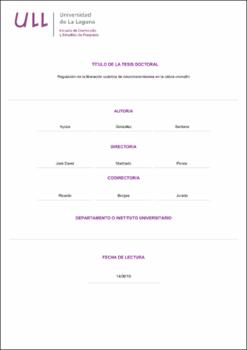Regulación de la liberación cuántica de neurotransmisores en la célula cromafín
Autor
González Santana, Ayoze
Fecha
2019Resumen
La exocitosis, un proceso esencial para la vida, es el principal mecanismo de comunicación celular y está presente en todas las células de forma constitutiva. La exocitosis regulada dependiente de Ca2+ consiste en la fusión de una vesícula secretora con la membrana plasmática, de tal manera que las sustancias almacenadas en su interior se liberan al medio extracelular. De la regulación de este proceso, tanto en el número de vesículas secretadas como en la cantidad y la manera en la que cada vesícula libere su contenido, depende la comunicación neuronal y la capacidad secretora de diversas células neuroendocrinas del organismo. En esta Tesis hemos realizado un estudio de los factores biológicos que afectan a la regulación del tamaño cuántico y a la cinética de la exocitosis en células cromafines adrenomedulares.
Por un lado, hemos ahondado en algunas de las vías de señalización que controlan la exocitosis, específicamente la vía del adenosín monofosfato cíclico (AMPc), que se activa tras la estimulación del receptor de incretinas glucagon-like peptide-1 (GLP-1R). La activación del GLP-1R da lugar a un incremento de AMPc que actúa, a través de proteína quinasa A (PKA), modulando el último paso de la exocitosis de catecolaminas (CAs) en las células cromafines. De esta forma, se promueve la liberación de mayor cantidad de neurotransmisores por vesícula.
Por otro lado, hemos realizado una caracterización de la exocitosis en células cromafines carentes de adrenalina por medio del uso de ratones knock-out para la enzima feniletanolamina-N-metil-transferasa (PNMT). Comprobamos que existe una fuerte especialización entre el fenotipo de célula cromafín y la CA que acumula. Así, células adrenérgicas conteniendo noradrenalina no son capaces de retener esa amina con la misma afinidad con la que retienen la CA que le es propia, la adrenalina, lo cual conlleva a una disminución del contenido de CAs totales. Exocytosis is an essential process for life, being the main mechanism for cellular communication and it is present in all cells in a constitutive way. Conversely, regulated exocytosis is a Ca2 +-dependent process which entails the fusion of a secretory vesicle with the plasma membrane, thus allowing the release of stored substances to the extracellular medium. The success of neuronal communication and the secretory capacity of neuroendocrine cells depends on the regulation of this process, both the number of secreted vesicles as the amount of vesicle content released. In this Doctoral Thesis, we have studied the biological factors that affect the regulation of the quantum size and the kinetics of exocytosis in adrenomedullary chromaffin cells.
On one hand, we wanted to delve into some of the signaling pathways that control exocytosis, specifically the cyclic adenosine monophosphate (cAMP) pathway activated after stimulation of the glucagon-like peptide-1 incretin receptor (GLP-1R). The activation of GLP-1R induces an increase in cAMP acting through protein kinase A (PKA), modulating the last step of exocytosis of catecholamines (CAs) in chromaffin cells. This process promotes the increase in the release of neurotransmitters per vesicle.
On the other hand, we have made a characterization of exocytosis distinguishing between adrenergic and noradrenergic cells present in the adrenal medulla. Through the use of knockout phenylethanolamine-N-methyltransferase mice (PNMT-KO), we found that there is a strong specialization between the chromaffin cell phenotype and the CA that accumulate. Thus, adrenergic cells containing noradrenaline are not able to retain that amine with the same affinity as retain adrenaline, which leads to a decrease in the content of total CAs.





